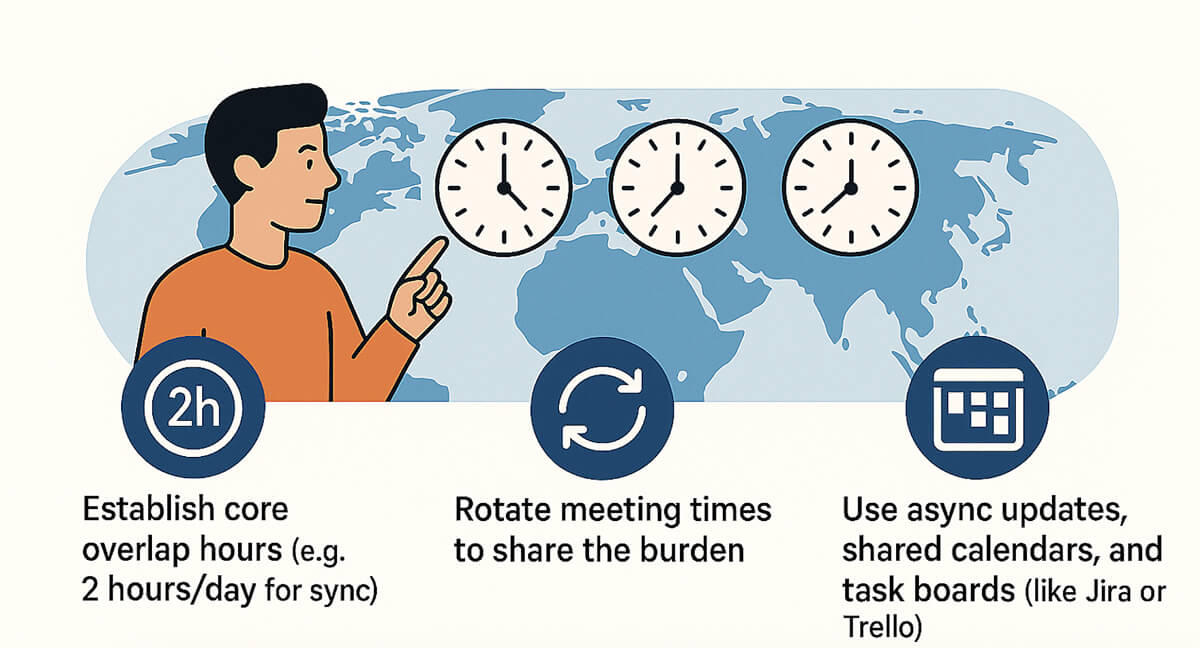Remote work is no longer a pandemic workaround. It has become the default operating model for tech talent. WFH Research data show that 27.9% of all U.S. paid working days were done from home in June 2025, a share that has increased for four consecutive quarters. Upwork projects that 32.6 million Americans (about one-fifth of the entire workforce) will be working remotely by year-end.
For engineering leaders, this shift means that managing remote developers is now a core business skill. Poor remote developer management can lead to significant issues like miscommunication, time-zone drag, and burnout. If managed properly, distributed teams unlock a whole new set of advantages, including global hiring pools and higher retention.
This guide breaks down what makes remote development teams work well, the pitfalls to avoid, and how to manage remote developers with confidence.
What Is a Remote Software Development Team?

A remote software team is a group of developers who work from different places. They might be spread across time zones, cities, countries, or continents.
Unlike hybrid or fully in-office teams, remote teams have some unique traits:
- They don’t share physical space. Interaction happens in GitHub, Jira, Slack, or Notion.
- Asynchronous first. Pull requests, RFCs, and recorded demos replace hallway chats.
- Documentation-driven culture. Decisions live in writing, so anyone can catch up.
This shift changes the way leaders manage remote teams. Without hallway chats or quick catch-ups, team bonding and communication don’t happen naturally. So, leaders must design workflows suitable for everyone.
What Does It Mean to Manage Remote Developers?
Managing remote developers isn’t about policing hours. It’s about engineering outcomes. You need to clarify goals, unblock flow, and create a culture where distributed engineers can deliver high-quality code autonomously.
Align the team on outcomes, not hours
- Measure progress by completed features, fixed bugs, and customer feedback.
- Let people choose working hours that fit their time zone as long as goals are met.
Communicate with intention
- Share updates in a clear, numbered list or short summary so everyone sees the same message.
- End each note with the next steps and who owns them.
Remove blockers, don’t micromanage
- Ask engineers what is stopping them, then clear approvals or fix the tools.
- Group similar questions in one place to avoid repeated interruptions.
Provide clear expectations and resources
- Write simple checklists that show what “done” means for each task.
- Give easy links to code guidelines, design docs, and helpful tools.
Support team well-being
- Hold short one-to-one calls to see how each person is doing, not just what they are doing.
- Encourage regular breaks and set a rule against sending messages during local late‑night hours.
Encourage autonomy and ownership
- Let developers decide how to solve their tasks within agreed limits.
- Praise completed work in a public channel, so people feel proud of their results.
Key Challenges in Managing Remote Developers
When people work in different time zones and can’t read each other’s body language, small problems can grow bigger. Solving these issues is more than half of a remote leader’s job.
1. Miscommunication Issues
Messages are often misunderstood without face-to-face meetings. Sometimes, messages are missed completely. A Harvard‑led study found that losing one hour of schedule overlap shrinks real‑time communication by 19%.
Tips:
- Use clear, simple language in all communication.
- Write down decisions and share meeting notes.
- Use video calls to clarify important topics.
- Encourage team members to ask questions and share updates regularly.
- Use collaboration tools like Slack or Microsoft Teams to stay connected.
2. Time Zone Coordination

It’s hard to schedule meetings with people in different countries. Disparate time zones make it even harder.
Tips:
- Establish core overlap hours (e.g., 2 hours/day for sync).
- Rotate meeting times to share the burden.
- Use asynchronous updates, shared calendars, and task boards (like Jira or Trello).
3. Tracking Work Without Micromanaging
Without clear visibility, some managers overuse check-ins or time tracking.
Tips:
- Shift from activity tracking to milestone tracking.
- Use project boards, burndown charts, and Git activity, rather than screen monitoring.
- Trust your team until given a reason not to.
4. Building Trust & Team Connection Remotely
Developers can feel isolated since remote work reduces opportunities for collaboration. It may also hurt team morale. A Future Forum survey notes 25% of fully remote employees report loneliness versus 16% of on‑site employees.
Tips:
- Schedule regular personal check-ins.
- Encourage casual chats and fun channels on Slack.
- Celebrate wins and birthdays online.
5. Maintaining Developer Motivation and Accountability
Without in-person recognition or peer energy, motivation can dip.
Tips:
- Give regular feedback. It can be praise or constructive.
- Tie OKRs to team outcomes (uptime, NPS) instead of individual commando coding.
- Create a knowledge-sharing environment.
6. Managing Work-Life Balance
In remote work, the line between home and work can become unclear. Developers may end up working too much, leading to burnout. For example, a developer might answer messages late at night. They may also work on weekends.
Tips:
- Encourage clear boundaries for work hours.
- Respect time off and avoid sending late-night messages.
- Promote healthy habits.
- Lead by example. Show balance in your schedule.
7. Handling Technology and Tool Issues
Remote teams depend on technology. Problems with the internet or tools can cause delays.
Tips:
- Provide the right tools and software for remote work.
- Offer support or reimbursements for better internet or equipment.
- Have backup plans for meetings, like dial-in options.
- Train the team on tools and best practices.
Remote vs. In-Person Leadership
How you see the work
- Office: You can glance across the room and know who is stuck.
- Remote: Progress shows up in pull requests, task boards, and written updates. You need to ask for status and trust the answers.
How people connect
- Office: Bonds form during coffee breaks and hallway chats without planning.
- Remote: Connection needs a schedule; virtual coffee calls, game sessions, or shout‑outs in chat can help keep spirits up.
How information travels
- Office: Quick questions get answered on the spot. Notes are often verbal.
- Remote: Almost everything must be written down so teammates in other time zones can catch up later.
How decisions are made
- Office: A short huddle at a whiteboard can settle an issue in minutes.
- Remote: Leaders write a brief, share it in chat, and wait for feedback. It takes longer, but the record is clear and searchable.
How trust is built
- Office: Presence and face‑to‑face talks build confidence.
- Remote: Trust grows from reliable delivery, clear communication, and quick help when blockers appear.
How to Improve as a Remote Team Leader
Here are some ways to improve your leadership skills in a remote team setting.
Keep information easy to find
- Store docs, specs, and decisions in one shared workspace (e.g., Notion or Confluence) so that anyone can look things up without waiting.
- Post brief status updates and link meeting notes to related tasks; this keeps context clear for every time zone.
Maintain simple weekly rhythms
- Start each week with a short video stand-up to set goals and surface blockers.
- End the sprint with a quick retrospective, agree on one improvement, and repeat at the same cadence.
Use tools with purpose
- Slack or Teams for quick questions; Jira or Trello for task tracking; Zoom or Meet for complex discussions.
- Encourage focus blocks by muting alerts during deep-work hours.
Keep feedback regular and clear
- Schedule monthly 1-to-1 chats to review goals and remove roadblocks.
- Base progress checks on agreed-upon outcomes, like stories finished or incidents resolved.
Support learning and growth
- Offer a modest budget for courses or certifications and have learners share highlights with the team.
- Rotate short “tech share” segments in team meetings to spread knowledge.
Build a positive culture
- Celebrate releases and personal milestones in a public channel to keep morale high.
- Host occasional virtual socials, coffee chats, or game breaks to replace hallway banter.
Conclusion
There is no single trick to running a good remote software team. Success comes from many small actions: set clear goals, write things down, give people room to work, and check in on their well-being.
The best remote teams are not just managed well. They are led well. Good leaders understand that connection, clear communication, and trust are key.


